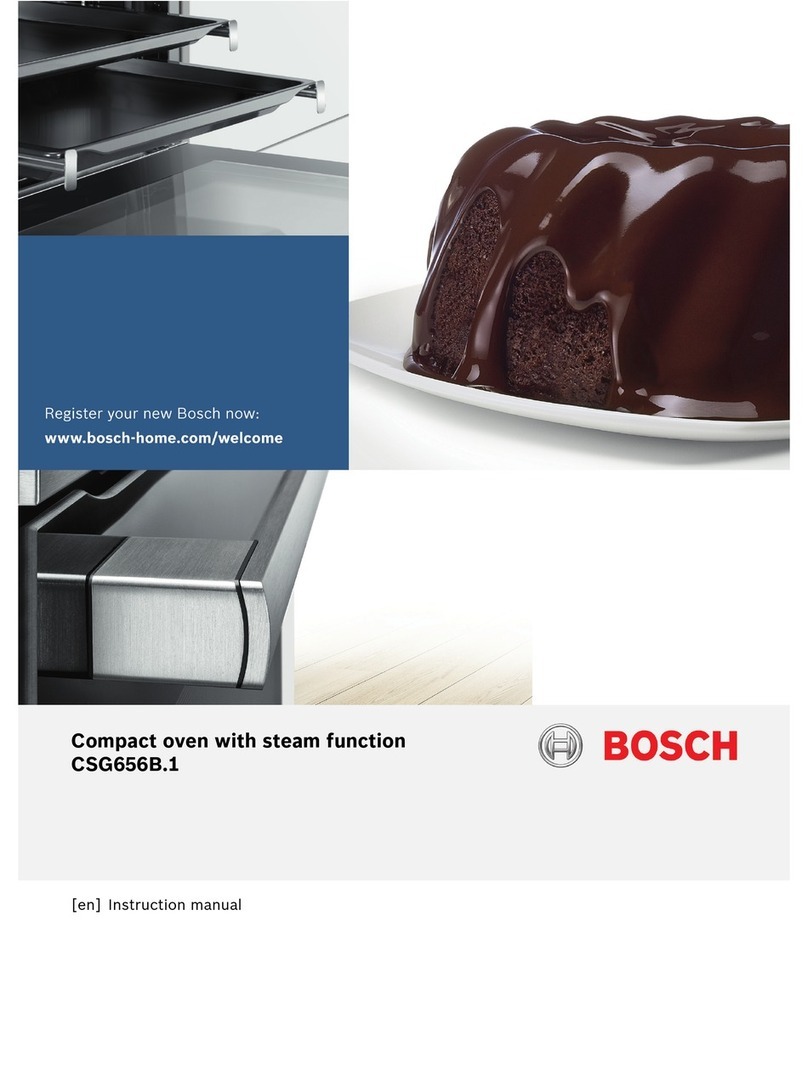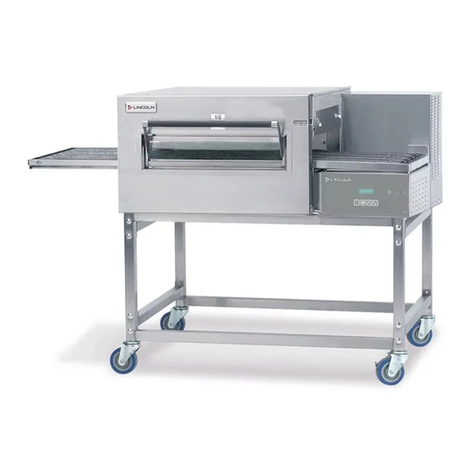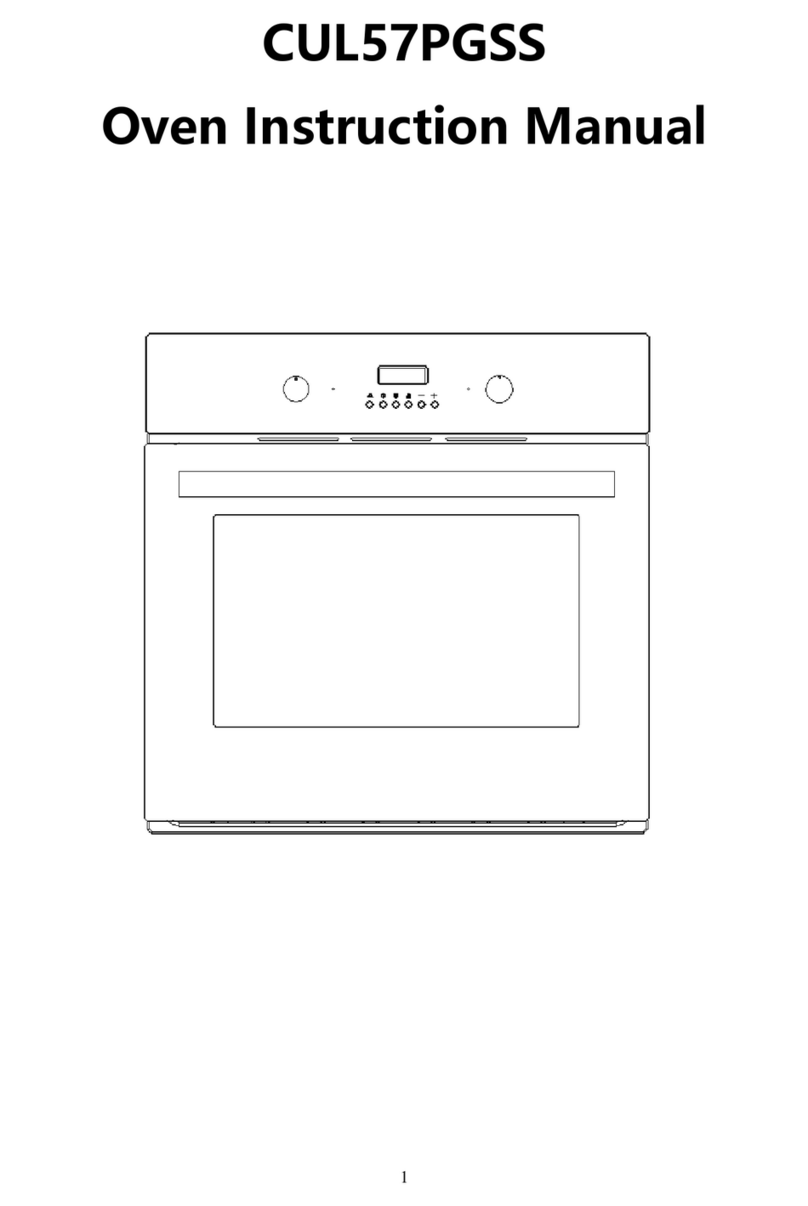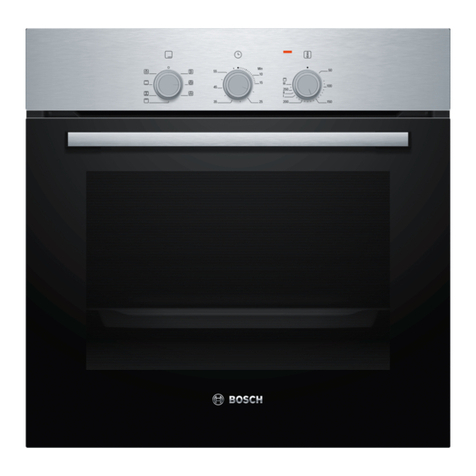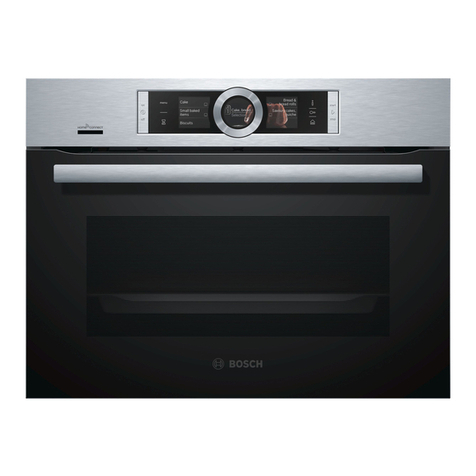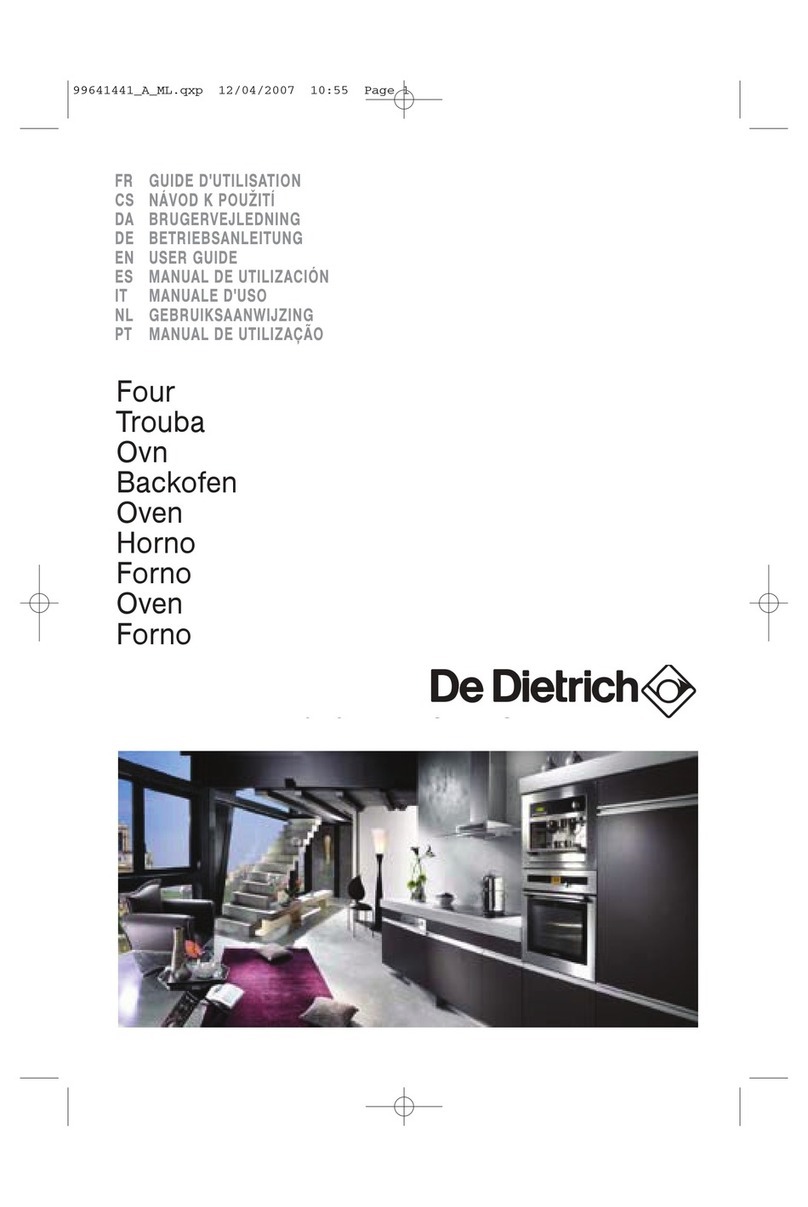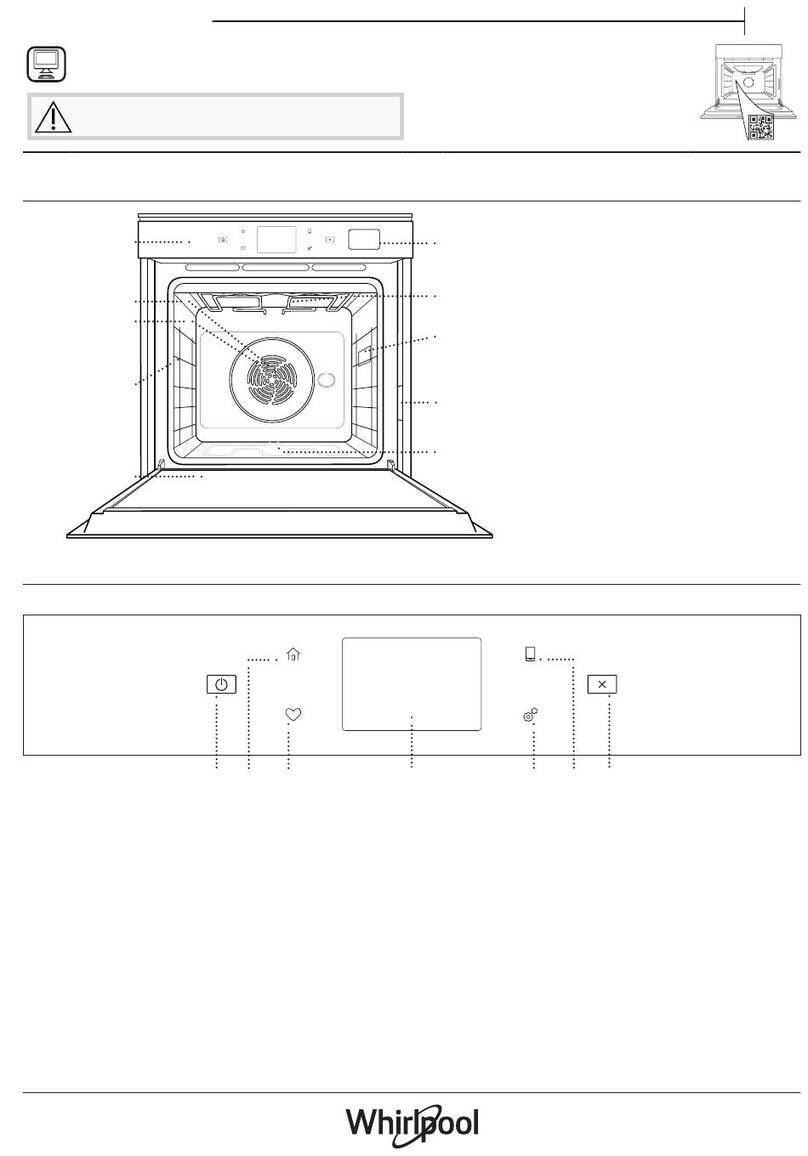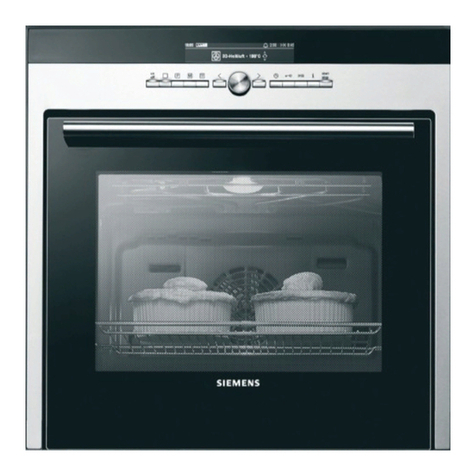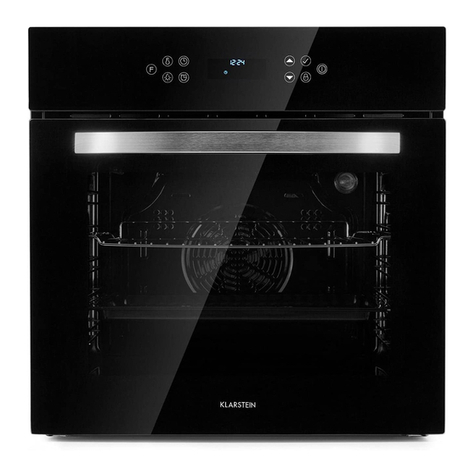TEKNIX BITK602ESB User manual

Instruction manual
Built-in Fan Oven
BITK602ESB
BITK602ESX
1

2

You’ll soon be enjoying your new Built-in Oven
It all begins here, with your instructions. Don’t worry,
there’s nothing too technical coming up. Just simple,
step-by-step guidance to get you up and running
quickly. Sound good? Then let’s get started.
3

3
Contents
21
22
23
25
26
26
Care and Maintenance
Cleaning
Replacing the lamps
Technical specification
Productsupport
Troubleshooting
Declaration of conformance to
product standards
Disposal
Warranty 27
5
6
6
9
10
12
13
15
16
17
Safety information
Safety information
Getting to know yourBuilt-
in Oven
Ready? Let’s begin
Accessories
Built-in
Using your Built-in Oven
Controls
1
2
3
4
Installing your
Oven
Cabinet installation
Electrical Connection
Oven functions Programming
General oven and Cooking tips
22
Removing the Inner pane of glass &
cleaning the glass
4

1
Safety information
5

Safety information
Important - Please read these instructions fully before
installing or operating
INSTALLATION WARNINGS
IMPORTANT: Prior to Installation ensure that
the local supply conditions (electricity voltage
and frequency are compatible with the
requirements of your built-in oven.
IMPORTANT: Carefully unpack and examine
the appliance for any damage. If you think
there is a defect, do not use the appliance
and contact Product Support on 01759
487823. Packaging materials should be
collected together and disposed of
immediately as they may be harmful to
children.
IMPORTANT: Keep the electrical cable (not
supplied of your built-in oven away from the
hot areas of your appliance, do not let the
cable touch the appliance. Keep the cable
away from sharp edges and heated surfaces.
IMPORTANT: Ensure that the electric supply
cable is not trapped or damaged during
installation.
IMPORTANT: In the event that the cable
connecting your built-in oven becomes
damaged, it must be replaced by a suitably
qualified person. This cable must not be
replaced by an unauthorised person.
IMPORTANT: Protect your built-in oven
against atmospheric effects. Do not expose
your oven to effects such as sun, rain, snow
etc.
IMPORTANT: The materials surrounding the
appliance (cabinets) must be able to
withstand a minimum temperature of 100°C.
IMPORTANT: When using your oven for the
first time your built-in oven may give off an
unusual odour from the heating elements and
insulation materials. This is normal for
cooking appliances. To eliminate this odour
run the oven at 250 degrees for 40-60 mins
with the oven empty.
WARNING: Before obtaining access to
terminals, all supply circuits must be
disconnected.
DURING USAGE
IMPORTANT: This appliance can be used by
children aged from 8 years and above and
persons with reduced physical, sensory or
mental capabilities or lack of experience and
knowledge if they have been given
supervision or instruction concerning use of
the appliance in a safe way and understand
the hazards involved. Children shall not play
with the appliance. Cleaning and user
maintenance shall not be made by children
without supervision.
WARNING: The appliance and its accessible
parts become hot during use. Care should be
taken to avoid touching heating elements.
Children less than 8 years of age shall be
kept away unless continuously supervised.
WARNING: NEVER try to extinguish a
cooking fire with water. Instead switch off the
appliance and cover flame e.g. with a lid or a
fire blanket.
CAUTION: Do not allow children in the
kitchen when cooking or after, as the parts
may still be hot. Many parts of the oven will
become hot and present a considerable
hazard to children.
CAUTION: When the oven is hot never touch
the oven glass by hand or with tools.
6

Safety information
Important - Please read these instructions fully before
installing or operating
CAUTION: Before starting to use your
appliance, ensure curtains, paper or
flammable items are kept away from your
appliance. Do not keep flammable materials
inside of or around your oven.
CAUTION: Take care when closing the oven
door that there is nothing obstructing it from
closing as this may break the glass door.
IMPORTANT: When using the grill the oven
door must be kept closed.
IMPORTANT: Make sure the oven control
knobs are all in the off position when not in
use.
IMPORTANT: If you do not intend to use your
built-in oven for a long period of time turn off
the electric supply to the oven.
GENERAL SAFETY WARNINGS
IMPORTANT: This appliance has been
designed for non-professional, domestic use
only. Do not use this oven for commercial use
or any other application e.g. room heating.
WARNING: Danger of fire: do not store
flammable items on or near the cooking
surfaces or inside the oven.
IMPORTANT: Do not try to lift or move this
appliance by pulling on the door handle.
WARNING: Ensure that the appliance is
switched off before replacing the lamp to
avoid the possibility of electric shock.
IMPORTANT: Your appliance is produced in
accordance with all applicable local and
international standards and regulations.
IMPORTANT: Maintenance and repair work
must only be performed by authorised
service technicians. Installation and repair
work that is carried out by unauthorised
technicians is dangerous and could invalidate
your guarantee.
IMPORTANT: When the door of the oven is
open, do not hang or lean anything on it. You
may unbalance your appliance or damage
the door or door hinges.
IMPORTANT: Do not hang towels, dishcloths
or clothes from the built-in oven or its
handles.
CLEANING AND MAINTENANCE
IMPORTANT: Always turn the appliance off
before operations such as cleaning or
maintenance. You can do this by switching
the built-in oven off using cooker isolation
switch.
IMPORTANT: Do not remove the control
knobs to clean the control panel.
WARNING: Do not use harsh abrasive
cleaners or sharp metal scrapers to clean the
oven door glass since they can scratch the
surface, which may result in shattering of the
glass.
TO MAINTAIN THE EFFICIENCY AND
SAFETY
OF YOUR APPLIANCE, WE RECOMMEND
YOU ALWAYS USE OUR AUTHORISED
SERVICE AGENTS AND ORIGINAL SPARE
PARTS.
FOR ASSISTANCE CALL PRODUCT
SUPPORT 01759 487823.
7

Getting to know your
Built-in Oven 2
8

Getting to know your Built-in Oven
You’ll be up and running in no time
Ready? Let’s begin...
Please read these instructions carefully. They contain
important information which will help you get the best
from your Built-in Oven and ensure safe and
correct installation and operation.
If you require any further assistance, our technical
experts are happy to help. For full details, refer to
the product support section at the end of these
instructions.
9

Getting to know your Built-in Oven
You’ll be up and running in no time
Built-in Oven Accessories
1.
2.
3.
4.
1 x Baking tray
1 x Grill insert
1 x Grill pan handle
1 x Chrome shelf
Tools needed for installation
Cross head screwdriver
Electric drill
Tape measure
Pencil
5. 1 x User Manual
6. 1 x Fixing kit
3
1
2
4
6
10

Installing your
Built-in Oven 3
11

Installing your Built-in Oven
Bringing it all together
Installation
This appliance should be installed by a competent person or qualified electrician in a accordance with the
regulations in force (All relevant British Standard/ Codes of Practice/relevant Building/IET regulations) and in
a well ventilated space. Please read instructions before installing and using this appliance.
Important: - The power supply to the appliance must be switched o° before any adjustments or maintenance work
is carried out.
Installation of Built-in Ovens
In order to ensure that the built-in appliance functions properly, the cabinet containing it must be appropriate .The
figur below gives the dimensions of the cut-out for installation under the counter or in a wall cabinet unit.
The worktop and any associated hob should be fitted BEFORE installing this oven.
It is recommended that if installing a built-in oven directly under the hob then there should be a minimum air gap of
20 mm between the oven and the bottom of the hob. Failure to maintain a suitable clearance may impair the
performance of the hob.
Ensure that air can flow freely around the housing area. If the oven is being installed into a fully enclosed built-under
oven housing unit it may be necessary to cut a small slot in the top of the plinth fitted under the unit. Cut a sectio in
the centre of the plinth that is 400mm wide and 45mm deep to allow air to pass under the unit. Alternatively cut a
section 400 x 450mm in the base of the centre of the plinth.
Failure to allow adequate ventilation to the appliance may result in overheating or damage to adjacent units and could
invalidate the guarantee. Surfaces of furniture and walls adjacent to the appliance should be heat, splash and steam
resistant. All cabinet doors must be at least 4mm from the oven at all points.
Certain types of vinyl or laminate kitchen furniture are particularly prone to heat damage and discolouration.
When placing the oven in the housing, do not use the oven door or handle as a lever for lifting the oven as damage
may result. When you open the oven door, you will see 2 screw holes on either side of the oven where you fix the
oven to the cabinetry.
The oven should then be secured to the housing by fitting screw provided into these holes.
Built-under Oven Housing
570
577.2
498
594
594
min565
45
595
16.8
570
min565
595
45
min
45
min
21
577.2
498
594
594
16.8
21
595
595
12

Installing your Built-in Oven
Bringing it all together
Provision for Ventilation
The appliance housing used must provide adequate ventilation.
For built-in installation, a minimum ventilation space of
85 – 90mm 40mm must exist between the rear of the appliance and the back of the housing
or an adjacent wall.
If a tall housing is to be installed flush with the ceiling, a 20cm² ventilation cut-out must be
provided at the top of the housing.
Electrical Connection
This appliance must be installed by a qualified electrician to comply with the relevant Institution of
Engineering and Technology (I.E.T. regulations and also the local electricity supply company
requirements.
This appliance must not be connected to an ordinary domestic power point.
This product comes fitted with a BS plug and cord.
Ensure the cable route avoids the risk of trapping or touching hot surfaces.
The oven is supplied with a BS plug and cord. In the case of replacement of cable or repair, please call our experts on
01759 487823.
Installing Shelves
13

Using your Built-in Oven 4
14

Using your Built-in Oven
Chrome wire shelf
5 Function mode control knob
Temperature control knob
Oven lamp
A.
A
E
B C
D
B.
C.
D.
E. Baking tray
Getting started
15

Using your Built-in Oven
Getting the most from your appliance
Oven functions
Defrost
Oven Light
Grill
Oven light -The oven light will operate on all oven functions.
Grill -This is the top heating element. The extremely high and direct temperature of the grill makes it possible to
brown the surface of meats and roasts while locking the juices in to keep them tender. The grill
is also highly recommended for dishes that require a high temperature on the surface: beef steaks, veal, rib
steak, fillets, hamburgers etc.
Fan grill -This function uses the fan to circulate the heat from the grill element around the food. This helps prevent
food from burning on the surface, allowing the heat to penetrate right into the food. Excellent results are achieved
with kebabs made with meats and vegetables, sausages, ribs lamb chops, chicken in a spicy sauce, quail, pork
Fan Grill
chops, etc.
Convectional heat -This function uses the top and bottom heating elements. Natural convection creates a perfect
cooking zone in the centre of the oven, ideal for dark fruit cakes and pastries or a joints of meat.
Using your appliance for the first time
The first time you use your appliance, we recommend that you set the temperature setting to the
250 degrees. Set the cooking mode selection knob to fan assisted mode and leave the oven on for 40-60
minutes with nothing in it and the oven door shut. Then, open the oven door and allow the oven to
cool. Any odour that may be detected during this initial use is due to the evaporation of substances used
Defrost - When set to ‘Defrost’ mode, the fan located at the back of the oven circulates room temperature air
around the food. This is recommended for the defrosting of all types of food, but in particular for delicate
types of food which do not require heat, for example: ice cream cakes, cream or custard desserts, fruit cakes, etc.
Fan oven-When set to Fan oven mode, the fan element and the fan operate providing a delicate heat
distributed uniformly throughout the oven. This mode is ideal for baking and cooking delicate foods on
multiple shelves, especially cakes that Swiss rolls and small portions of vegetables, etc.
By using ‘Defrost’ mode, the defrosting time is approximately halved.
to protect the oven during storage.
Fan oven
16

General oven and cooking tips
General Oven Tips
The wire shelves should always be pushed firmly to the back of the oven.
Baking trays with food cooking on them should be placed level with the front edge of the oven’s
wire shelves. Other containers should be placed centrally. Keep all trays and containers away from
the back of the oven, as over-browning of the food may occur.
For even browning, the maximum recommended size of a baking tray is 340 mm (13½”) by 340
mm (13½”).
When the oven is on, do not leave the door open for longer than necessary, otherwise the knobs
may get very hot.
Always leave 1-2cm between dishes on the same shelf. This allows the heat to circulate freely
around them.
To reduce fat splashing when you add vegetables to hot fat around a roast, dry them thoroughly or
brush lightly with cooking oil.
Where dishes may boil and spill over during cooking, place them on a baking tray.
Using the Grill
This multi-function oven has 2 different grilling modes.
Use the ‘Grill’ mode with the oven door closed, place the food on the center of the grill pan, insert
and fit the grill pan on either the 3rd or 4th shelf from the bottom. Note: only the central part of the
top heating element operates for grilling.
When using ‘Grill’ mode, we recommend you set the temperature to the highest setting. However,
this does not mean you cannot use lower temperatures, simply adjust the knob to the desired
temperature.
Use ‘Fan assisted grill’ mode with the oven door closed. This mode is very useful for grilling foods
rapidly, as the distribution of heat by the fan makes it possible not only to brown the surface, but also
to cook the bottom of the food. It can also be used for browning foods at the end of the cooking
process, such as adding that gratin finish to pasta bakes.
When using ‘Fan assisted grill’ mode, place the food on the 2nd or 3rd oven shelf from the bottom,
then place a dripping-pan on the 1st rack from the bottom to prevent fat and grease from dripping
onto the oven floor. We recommend you set the temperature to 200°c, as it is the most efficient
temperature for ‘Fan assisted grill’ mode. However, this does not mean you cannot use lower
temperatures, simply adjust the knob to the desired temperature.
IMPORTANT: When using any of the oven functions you must cook with the oven door closed
including when using a grill function.
17

General oven and cooking tips
Baking cakes
When baking cakes, always place them in a preheated oven. Make sure you wait until the
oven has been preheated thoroughly (the indicator light will turn off). To prevent heat loss
and the cake from dropping, do not open the oven door during baking.
In general...
... if pastry is too dry
Increase the temperature by 10°C and reduce the cooking time.
... if pastry has dropped
Use less liquid or lower the temperature by 10°C.
... if pastry is too dark on top
Place it on a lower shelf, lower the temperature, and increase the cooking time.
... if cooked well on the inside but sticky on the outside
Use less liquid, lower the temperature, and increase the cooking time.
... if the pastry sticks to the pan
Grease the pan well and sprinkle it with a dusting of flour or use greaseproof paper.
... if I used multi shelf cooking and one shelf is more cooked
Use a lower temperature setting next time. It is not necessary to remove the food from all
the racks at the same time.
For best results when cooking pizza:
Cooking pizza -Suggested Function
Preheat the oven for at least 10 minutes.
Use a light aluminum pizza pan, placing it on the shelf supplied with the oven. Don’t use the
dripping pan since this will extend the cooking time, making it difficult to get a crispy crust.
Do not open the oven door frequently while the pizza is cooking;
If the pizza has a lot of toppings (three or four), we recommend you add the mozzarella
cheese on top halfway through the cooking process.
For best results, only use one shelf at a time, but if you want to cook on two shelves, use the
2nd and 4th racks from the bottom with a temperature of 220°c and swap them halfway
through cooking.
18

General oven and cooking tips
Cooking fish and meat-Suggested cooking function
When cooking white meat, fowl and fish, use a temperature setting from 180°C to
200°c.
For red meat that you want well done on the outside while tender and juicy in the
inside, it is best to start with a high temperature setting
(200°C-220°C) for a short time, then turn the oven down afterwards.
In general, the larger the roast, the lower the temperature setting. Place the meat on
the centre of the shelf and place the dripping pan beneath it to catch the fat.
Make sure that the shelf is inserted so that it is in the centre of the oven. If you would
like to increase the amount of heat from below, use a lower shelf height. For savoury
roasts (especially duck and wild game), dress the meat with lard or bacon on the top.
19

Care and maintenance 5
20
This manual suits for next models
1
Table of contents
Other TEKNIX Oven manuals






